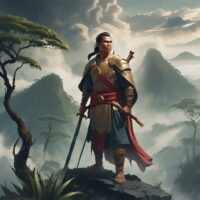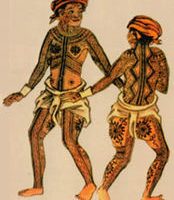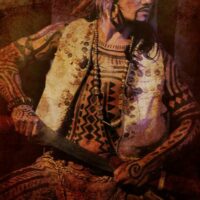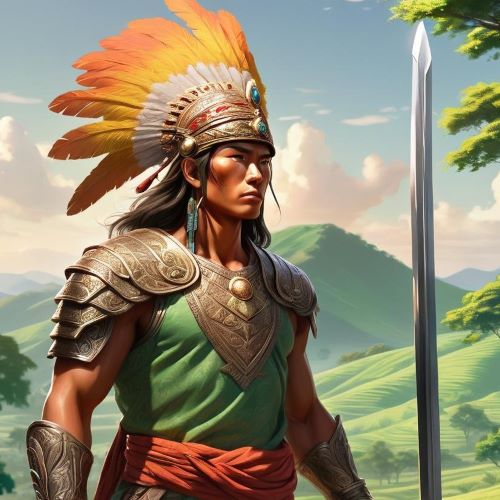Buyong Matanayon : The Skilled Swordsman
Listen
At a glance
| Description | |
|---|---|
| Origin | Philippine Mythology |
| Classification | Mortals |
| Family Members | N/A |
| Region | Philippines |
| Associated With | Swordsmanship, Bravery |
Buyong Matanayon
Introduction
Buyong Matanayon stands as a distinguished figure in Philippine mythology, specifically within the epic narrative of Hinilawod, one of the oldest and longest epics from the Visayas. He is revered not as a god or divine being, but as a mortal warrior whose extraordinary loyalty and combat skill elevate him to near-mythical status. As a steadfast ally to Humadapnon, one of the story’s central heroes, Buyong Matanayon embodies the archetype of the ideal warrior-companion—wise, courageous, and unwavering in the face of supernatural threats. His presence adds depth to the Hinilawod’s themes of heroism, friendship, and human agency amidst divine and magical realms.
Physical Traits
The epic does not provide an elaborate physical description of Buyong Matanayon, but his depiction as a “good swordsman” suggests much about his appearance and demeanor. He is imagined as a tall, agile, and battle-hardened man, likely with the lithe build of someone trained in the art of combat. His skills imply years of discipline and mastery, suggesting a physique suited for endurance and power. His association with Mount Matiula—often considered a place of spiritual or heroic origin—also hints at a noble or sacred quality. In cultural imagination, he would likely wear traditional Visayan attire, possibly adorned with battle insignias that reflect his valor and rank among warriors.
Family
Buyong Matanayon’s familial background is intricate, owing to the fluid nature of oral tradition and overlapping identities in Philippine epics. While he is frequently depicted as an ally and possibly a brother-in-arms to the heroic buyong brothers like Humadapnon and Labaw Donggon, his direct lineage remains somewhat ambiguous. In some interpretations, the character of Matan-ayon—who may be closely linked to or even synonymous with Buyong Matanayon—is described as being adopted by a powerful matriarch named Amburukay. In other instances, Matan-ayon is presented as a daughter of Buyong Paiburong. These variations reflect the layered storytelling of oral tradition, where familial roles shift and evolve across generations of narration. Whether as a brother, husband, or protector, Matanayon’s relationships signify his deep integration into the heroic world of Hinilawod.
Other names
Though predominantly known as Buyong Matanayon, variations in his naming appear across different tellings of the epic. The title “Buyong” is not a personal name but an honorific bestowed upon young noble warriors in Visayan society. “Matanayon” itself can be interpreted to mean enduring or steadfast, perfectly encapsulating his character’s essence. Interestingly, in some versions, a female figure named Matan-ayon assumes a male form—transforming into Buyong—highlighting a potential fluidity in identity that enriches the narrative’s complexity. These dual interpretations speak to the flexibility of oral epics, where names and roles shift depending on the context, location, or storyteller. Regardless of these shifts, the core attributes of bravery, loyalty, and intelligence remain constant.
Powers and Abilities
Buyong Matanayon’s power lies not in divinity but in human strength, intellect, and strategy. His swordsmanship is legendary, allowing him to stand toe-to-toe with sorcerers, monsters, and rival warriors. More than brute force, it is his sharp mind that often turns the tide of battle. When Humadapnon is trapped by the enchantress Piganun, it is Matanayon who remembers the power of burning ginger—an ancient practice believed to dispel witchcraft—and uses it to break the spell. His ability to identify and counter magical forces demonstrates a deep understanding of both combat and indigenous knowledge systems. In another episode, he navigates through magical landscapes like the Region of Eternal Darkness and Tarambang Buriraw, maintaining composure and focus, traits essential for survival in these perilous realms. In some versions of the tale, Matanayon—or Matan-ayon—can transform into water to escape danger, suggesting that, in certain tellings, he possesses shapeshifting abilities rooted in indigenous animist beliefs.
Modern Day Influence
Buyong Matanayon’s presence lingers in modern Philippine culture through education, art, and cultural preservation. As a key figure in Hinilawod, his story is taught in literature courses across the Philippines, reinforcing his role as a symbol of courage, intelligence, and loyalty. The epic is often recited or dramatized in festivals in the Panay region, where Matanayon is brought to life on stage, connecting younger generations to their ancestral narratives. His combat style and wisdom also find echoes in Filipino martial arts, where traditional weapons like the kampilan evoke images of legendary warriors like him. In popular media and storytelling, the character of the wise companion or loyal warrior mentor often draws inspiration—consciously or unconsciously—from figures like Buyong Matanayon. Through him, the ideals of valor and steadfastness continue to resonate, ensuring that even in a rapidly changing world, the essence of indigenous heroism remains rooted in the Filipino imagination.
By weaving together loyalty, strategy, and cultural heritage, Buyong Matanayon exemplifies the enduring power of human strength in mythological storytelling. Though not divine, he stands as a testament to the belief that mortals, too, can achieve greatness—through courage, wisdom, and a deep understanding of the world around them.
Related Images
Source
Jocano, F. L. (1969). Outline of Philippine Mythology. Centro Escolar University Research and Development Center.
Jocano, F. L. (2005). Hinilawod: Adventures of Humadapnon. Punlad Research House.
Clark, J. (2021, July 27). Three Brothers of Panay: Excerpt from the Suludnon Epic “Hinilawod”. The Aswang Project. https://www.aswangproject.com/hinilawod-suludnon/
Wikipedia contributors. (2025). Hinilawod. Wikipedia. https://en.wikipedia.org/wiki/Hinilawod
De los Santos, N. (2022, October 11). The Adventures of Humadapnon. Nathalie De Los Santos Blog. https://natdls.com/blog/hinilawod-part-4-the-adventures-of-humadapnon
Frequently Asked Questions
What is lorem Ipsum?
I am text block. Click edit button to change this text. Lorem ipsum dolor sit amet, consectetur adipiscing elit. Ut elit tellus, luctus nec ullamcorper mattis, pulvinar dapibus leo.
What is lorem Ipsum?
I am text block. Click edit button to change this text. Lorem ipsum dolor sit amet, consectetur adipiscing elit. Ut elit tellus, luctus nec ullamcorper mattis, pulvinar dapibus leo.
What is lorem Ipsum?
I am text block. Click edit button to change this text. Lorem ipsum dolor sit amet, consectetur adipiscing elit. Ut elit tellus, luctus nec ullamcorper mattis, pulvinar dapibus leo.
What is lorem Ipsum?
I am text block. Click edit button to change this text. Lorem ipsum dolor sit amet, consectetur adipiscing elit. Ut elit tellus, luctus nec ullamcorper mattis, pulvinar dapibus leo.
What is lorem Ipsum?
I am text block. Click edit button to change this text. Lorem ipsum dolor sit amet, consectetur adipiscing elit. Ut elit tellus, luctus nec ullamcorper mattis, pulvinar dapibus leo.









